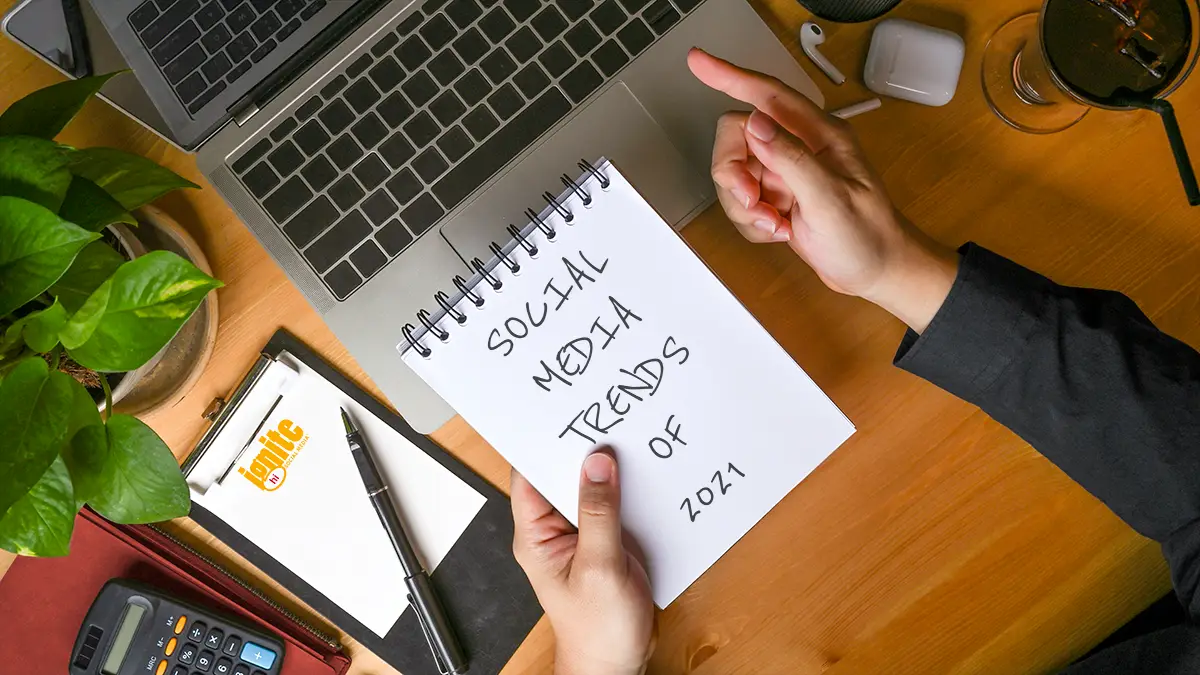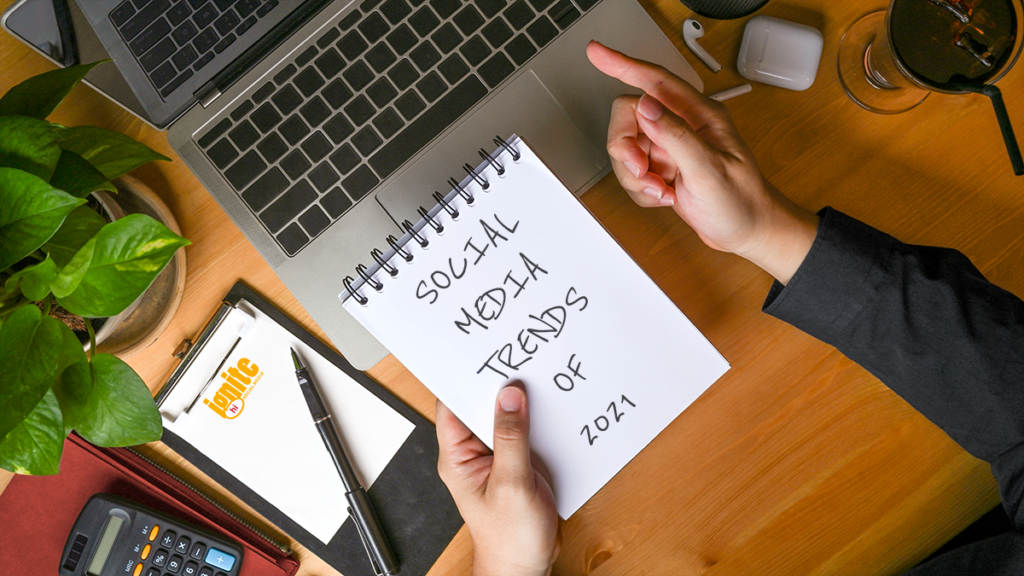
31 Aug Social Media Trends of 2021 That Top Organizations Are Capitalizing On
It’s hard to believe we are now approaching the end of 2021 when it sometimes feels 2020 was only yesterday. Last year was certainly full of changes and uncertainties. We saw major shifts in all aspects of our lives and businesses. 2020 also made a significant impact on the state of social media, evolving trends, and what the world deems important in life and from brands.
Here’s a look at a few of the social media trends of 2021 that top organizations are capitalizing on this year:
People Love to Shop Small
One of the earliest trends we saw last year that has continued to grow is the support of local and small businesses. People were searching for ways to help others in a safe way, and shopping – especially online – was an attainable solution.
The rise of social commerce has only helped these smaller businesses reach a larger audience and grow. Platforms have begun testing new ways to benefit brands on social: Facebook launched Shops, Pinterest unveiled a new Shop Tab, and Instagram Checkout allows users to make a purchase without ever leaving the app.
The data backs up this trend as well. A survey last year revealed that 82.76 % of shoppers say they would rather support a local business than a large corporation. A staggering eight out of ten shoppers are willing to spend more money at their local business.
Another reason shopping small has become so popular is the ability for shoppers to have a more personalized experience. According to a study, small businesses reply more than their larger counterparts. These small businesses reply on average 25% of the time compared to large businesses at 12% and global businesses at 9%. It’s no surprise customers want to be heard by brands and feel taken care of when shopping. By excelling in community management, brands can enhance their online presence and relationship-building with consumers.
What last year was an effort to boost the local economy and do good in one’s community has become a new way of shopping for many. It’s a “win-win” situation – the shopper feels good about supporting local, and the local business is able to see another day and hopefully thrive. Many also see small businesses as a more personalized shopping experience and one in which the brand truly cares about the shopper – something larger brands should consider when looking at how they approach their audience.
Cause Marketing Continues to Thrive
Sprout Social notes, “People today feel more divided than united – and it’s all too easy to see why. Political discussions veer toward ‘right vs. wrong’… Sharing an opinion can quickly devolve into name-calling and fighting… And online, this all happens at the speed of social.”
However, many still believe social media brings the opportunity to heal wounds and connect people to causes they care about. Followers are only increasingly caring about what a brand stands for in this day and age.
eMarketer surveyed adults worldwide on factors they would rate as critical/important when deciding which brands to buy or use, and here were the results:
- 88% feel they must trust a brand
- 85% deem a brand needs to have a good reputation
- 76% want the brand to have a small negative impact on the environment if possible
- 66% feel it’s critical the brand actively supports a cause or speaks out on social issues they care about
- 63% want owning or using a brand to say something positive about and reflect well on them
With this information, it’s no surprise consumers tend to follow or purchase from brands they feel they align with through their values and positioning. Followers want to feel connected to a brand – they care about relatability.
How can we connect with our audience? Listen to your followers, determine what’s important to your brand, and showcase employees, and share how your brand is involved and doing good in the community. The right audience with similar key values will find meaning in this content.
People are Focused on Inclusivity
2020 escalated the need for phones and social – these devices have become more critical than ever before as people longed for connection. As a result, platforms have begun making sure everyone can participate in these conversations and have a voice. Diversity and accessibility on social media platforms allow everyone to be invited to the party.
As an example of its diversity endeavors, Pinterest laid out some of its efforts, aligned with many other platforms. They integrated new skin tone ranges with their Try-On products. The platform also eliminated any skin smoothing or altering features ability in AR (allowing the AR Try On to be more “actual reality” than augmented). Finally, they banned weight-loss ads – a first in their industry.
Accessibility is defined as “an inclusive design which aims to provide the best user experience for as many people as possible. At least one billion people—15% of the world’s population—experience some form of disability today. So when content is not accessible, brands are missing a large potential audience. How can brands be more inclusive in design?
- Make text accessible (plain text, camel case hashtags, avoiding overuse of all caps, avoiding special characters, etc.)
- Provide descriptive image captions.
- Include video captions
- Add video descriptions
- Stay informed about accessibility tools
In 2021, we’ve seen great strides in promoting inclusivity and accessibility. Companies have launched promotional campaigns focused on these attributes. Platforms have begun new ways to become more accessible to a broader audience. Brands are listening to their followers more to see what matters. While we’ve seen this social media trend rise over the past 5 years, 2020 accelerated it to a new level. As we discussed followers caring about a brand’s key values earlier, the importance of inclusivity and diversity holds great significance to many followers.
Brands Need to Read the Room
These days, smart brands are understanding the need to consider readers. For example, in “Mindset in the Moment” conspicuous consumption is out. The world was less infatuated with billionaires going to space when people are still suffering and recovering from the past year. When just two years ago, these efforts may have been deemed heroic or these people may have been hailed as pioneers or scientists, this year, people saw it more as a waste and flaunt of money.
Many are still in the same fight of 2020 or just starting the road to recovery. There is still a great deal of angst with COVID, politics, climate change, etc., and brands need to be sensitive to this when planning content or making statements.
One thing to note though is today, our latest group of survey respondents (a majority 80%) are comfortable with brands running ads right now. However, about a fourth of those who are comfortable with ads do feel there are still some restrictions brands should be mindful of – for example, only running ads if their product is essential or if the message is sensitive.
Still, it is worth recognizing that much of this is dependent on a case-by-case scenario in determining whether or not brands need to pause social media ads, pandemic or not. When a life-altering event occurs, such as a mass shooting or a natural disaster, brands should perform an evaluation as soon as possible and be prepared to adjust their content strategy on social channels. For additional information on this, please see the following post for guidance on best practices when temporarily pausing your advertising efforts.
People are Spending Differently
After a year of no travel, 2021 has seen an increase in travel spending and searches on social media. People have begun getting together again and seeing friends and family. Many are trying to fit in travel that they missed out on last year, increasing their spending on travel expenses.
However, as more people are traveling and shopping in stores, they are spending less time on their phones and computers scrolling social media. Pinterest users dropped by 24 million in Q2. They attributed this loss to “the global vaccine roll-out, and the re-opening of physical stores, which has impacted the adoption of eCommerce and online browsing.” However, the overall use of the platform is still stable. Pinterest did mention that shopping and search engagement remain steady and that users are discovering and buying through the app.
Many platforms are trying to find ways to become beneficial for brands as a result of the difference in consumer attitudes and spending habits, showcasing current trends or how the users are behaving at different times of the year. Both Snapchat and Pinterest release reports of their followers and how they behave (whether attitudes towards the Super Bowl or around the holidays).
Pinterest has a “Pinterest Predicts” that alerts what social media trends they see happening in different categories – home, fashion, food, etc. The platform also identified 6 types of travelers you can find on the site and how brands can best determine ad spending and targeting these different audiences. They cited that searches for travel increased 60% year over year on Pinterest.
Whether it’s fine-tuning ad targeting or finding inspiration for new content, brands can utilize these platform insights to best determine a strategy moving forward as people continue to change throughout the year.
The World Craves Nostalgia
After major world events such as 9/11, the recession, and now the pandemic, people crave comfort and familiarity. Nostalgia tends to make a comeback in the aftermath of these events to fulfill these longings of peace and solace.
According to Market Blazer, “Nostalgia marketing uses imagery, music, or pop culture references from the past to tap into our collective longing for a simpler past. It creates a “remember when” feeling that helps your audience feel more connected to you and your brand. Millennials respond particularly well to nostalgia marketing. Now in their mid-20s to mid-30s, these young adults are looking back to a time before social media and constant connectivity, when your neighborhood was your world.”
We are seeing brands bring back these throwbacks. During the Super Bowl, Frito-Lay launched an ad featuring actors such as Matthew McConaughey to reintroduce Doritos 3D Crunch – a product from the 1990s. Cheetos hired married couple Ashton Kutcher and Mila Kunis of “That ’70s Show” fame and singer Shaggy for an updated version of the Shaggy’s hit “It Wasn’t Me” from 2000. Uber Eats brought back together Wayne and Garth from “Wayne’s World” for a spot during the telecast.
Victoria Petrock, an eMarketer principal analyst at Insider Intelligence explains, “During times of distress, it’s a natural coping mechanism for people to want to think about happier times. People are baking homemade bread, doing jigsaw puzzles, and listening to classic music from decades past to try to find comfort in those experiences.”
So how can brands utilize nostalgia marketing? The ways can vary depending on the size of the company, but below are a few ideas for inspiration.
- Then vs. Now posts
- “Retro-fying” logos, social, brand, etc.
- Throwback content or products
- References from previous decades that resonate with your audience
Inspirational content – many are nostalgic for times before the pandemic. Give followers a reason to be hopeful for the future.
If you’re looking for some assistance incorporating these trends into your brand’s social media marketing strategy, contact our team today. Alternatively, keep yourself up-to-date on new tools and features, as well as other social media trends by subscribing to our e-newsletter below.
Subscribe to Social You Should Know








